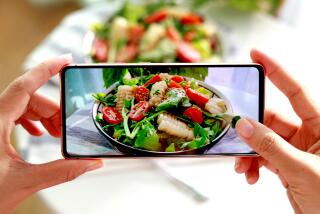Cravings could be defeated with two little words
Why is it that we crave chocolate chip cookies rather than chard? Or bread instead of broccoli? Take heart: Itâs biological.
âOur attraction to sweets â and salt, carbohydrates and fat â is hard-wired from the Stone Age,â says Dr. David Katz, director of Yale Universityâs Prevention Research Center. Back then, food cravings were reliable signals to our ancestors to seek out certain foods that would provide energy (sugar, fat) and essential minerals (salt).
âToday, food is plentiful and itâs easy to avoid physical activity, but weâve preserved craving tendencies because evolution is very slow,â Katz says. And cravings are just one more reason that obesity is an epidemic in this country. So is there anything you can do to fight these deep-rooted desires?
For starters, try a reframing exercise that seems to work for all sorts of yearnings. Itâs actually pretty easy: When deciding whether to eat something that isnât necessarily nutritious, use the words âI donâtâ instead of âI canât.â
Whatâs the difference? âWith âI donâtâ youâre choosing words that signal empowerment and determination rather than ones that signal deprivation,â says Vanessa Patrick, an associate professor of marketing at the University of Houston. In four studies, Patrick and her colleagues examined how âempowered refusalâ can increase feelings of control and self-awareness, especially with food. They found that when it came to deciding whether to eat certain foods, saying âI donâtâ was nearly three times as effective as saying ânoâ and about eight times more effective than saying âI canât.â The research was published in Marchâs Journal of Consumer Research.
Read on for explanations about why we crave certain foods and why we should just say âI donât.â
The craving: Sugar
Why itâs tempting: âWhen you taste something sweet, like a caramel or slice of apple pie, it triggers your brain to release opioids and dopamine, which are âfeel-goodâ neurochemicals,â says Elisabetta Politi, a registered dietitian and nutrition director at the Duke University Diet and Fitness Center. Thatâs right: One chunk of chocolate-covered toffee leads to love at first bite.
And why to say âI donâtâ: Can we become addicted to sugar and physically crave it? Some research suggests we can. In the February issue of Nature, Dr. Robert Lustig, professor of pediatrics at UC San Francisco, argued that sugar is as addictive as alcohol and tobacco and should be regulated. And in 2007, psychologists at Princeton University reported that when rats are fed sugar, they become dependent on the opioids that their brains produce. The researchers concluded that some of the results may also apply to humans.
Give in without going overboard: âPlan ahead,â says Politi. âIf you know you are going to an event where youâll have dessert in the evening, be more mindful of what youâre eating throughout the day.â If weight loss is a goal, she recommends that you consider the caloric cost of certain foods and then determine â also ahead of time â if youâre willing to increase the amount of exercise it would take to have a net-zero effect. For instance, to burn off the 400-plus calories in a slice of apple pie, youâd need to walk for about 90 minutes (at a 4 mph pace). Politi advises keeping food and exercise journals. Sometimes just doing the math will stave off the craving.
The Craving: Refined carbohydrates
Why theyâre tempting: Carbohydrates, in the form of cookies, bread, pasta and rice, confer quick energy. âFrom an evolutionary standpoint, starches and sugars were the easiest fuel to find for the tank,â says Katz. Plus, physical activity was unavoidable. Today, not so much.
And why to say âI donâtâ: Since weâre not burning calories by chasing dinner, or running away from an animal that sees us as dinner, we donât need to get more than 45% of our daily calories from carbohydrates (and most of these should come from complex sources, such as whole grains and fruits and vegetables). When we consume more carbohydrates than we burn off, whatâs left is stored as fat.
Give in without going overboard: First, âunjunk yourself.â This is Katzâs term for cutting out most carb-laden snack foods; they have little nutritional value. (Katz produced an entertaining public service announcement, in the form of a hip-hop video, called âUnjunk Yourselfâ.) âIf you stop eating overly processed and sugar-laden foods, and start eating foods that come from nature, youâll find that your taste buds actually change and you crave the junk less,â Katz says. Then, when you really want to have a cookie or whatever your proverbial poison, it will be a treat instead of part of an unhealthful routine.
The craving: Salt/sodium
Why itâs tempting: âWhen we hauled out of the salty brine, we left sodium behind,â says Katz. Sodium is rewarding and necessary because it maintains fluid balance in the body, helps transmit nerve impulses and plays a role in muscle function. But we need a fraction of what we consume, in part because sodium, like sugar, is in everything, including breakfast cereal and frozen coffee drinks. Most of the sodium we consume these days is added to foods as a preservative rather than shaken onto foods at the table (sodium is an ingredient of salt). But table salt is often added to restaurant-prepared meals because it retains heat and enhances flavor.
And why to say âI donâtâ: Consuming high levels of sodium makes otherwise healthy people prone to gastric cancers. Researchers believe itâs because in high doses sodium damages the lining of the stomach.
Give in without going overboard: The next time you have an itch for a salty snack, reach for a handful â a small one â of salted nuts, Katz advises. There is nothing we âneedâ in a bag of potato chips. In cooking, experiment with dill, basil, lemon, garlic, ginger or rice vinegar to enhance flavors.
The craving: Fat
Why itâs tempting: In a word: satisfaction. âWe have the biological drive to seek out fatty foods because theyâre calorie-dense and give us long-lasting energy,â says Susan Bowerman, a registered dietitian and assistant director of the UCLA Center for Human Nutrition. Whatâs more, âFat enhances flavor, sort of like salt does, and it adds all sorts of textural qualities to foods,â she says. (Just compare the taste and âmouth feelâ of a turkey burger to a beef burger, says Bowerman.)
And why to say âI donâtâ: Because calories are so plentiful in our modern age, we donât need to stock up on fat. And by now everyone knows that eating too much fat, especially saturated fat found in meats, dairy products and baked goods, is linked to all sorts of health problems, including obesity, heart disease and stroke.
Give in without going overboard: First, if you decide to cut back on saturated fat, and chances are good that you should, âgive your palate some time to adjust to eating less fat,â Bowerman says. Use healthier monounsaturated and polyunsaturated fats to add flavor to low-fat foods. âToasted sesame oil, walnut oil and good quality olive oil are healthier and super flavorful,â Bowerman says. âGreek yogurt is amazingly thick and creamy and can be used in placed of sour cream.â In baked goods, replace half the fat the recipe calls for with apple sauce. Your heart and your waistline will thank you.






